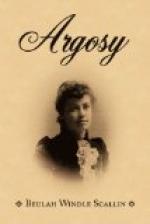Quiet indeed they were, with a look about them yet more old-world, deadly and deserted even than St. Pol de Leon. The houses are nearly all built of that grey Kersanton stone, which has a cold and cheerless tone full of melancholy; like some of the far away Scotch or Welsh villages, where nature seems to have died out, no verdure is to be seen, and the very hedges, that in softer climes bud and blossom and put forth the promise of spring to make glad the heart of man, are replaced by dry walls that have no beauty in them.
Yet at once we felt that there was a certain charm about Roscoff, and a very marked individuality. Never yet, in Brittany, had we felt so out of the world and removed from civilization. Its quaint houses are substantial though small, and many of them still possess the old cellars that open by large winged doors into the streets, where the poorer people live an underground life resembling that of the moles. The cellars go far back, and light never penetrates into their recesses.
Again, some of the houses had courtyards of quaint and interesting architecture. One of them especially is worth visiting. A long narrow passage leads you to a quaint yard with seven arches supported by columns, with an upper gallery supported by more columns. It might have formed part of a miniature cloister in days gone by.
On the way towards the church, we passed the chapel dedicated to St. Ninian, of which nothing remains now but the bare enclosure and the ancient and beautiful gateway. This, ruined as it is, is the most interesting relic in Roscoff. It was here that Mary Queen of Scots landed when only five years old, to be married to the Dauphin of France. The form of her foot was cut out in the rock on which she first stepped, but we failed to see it. Perhaps time and the effect of winds and waves have worn it away. Footsteps disappear even on a stronger foundation than the sands of time. The little chapel was built to commemorate her landing, and its ruins are surrounded by a halo of sadness and romance. Four days after her landing she was betrothed. But the happy careless childhood was quickly to pass away; the “fevered life of a throne” was most essentially to be hers; plot and counterplot were to embitter her days; until at last, at the bidding of “great Elizabeth,” those wonderful eyes were to close for the last time upon the world, and that lovely head was to be laid upon the block.
The sad history overshadows the little chapel in Roscoff as a halo; for us overshadowed the whole town.
Adjoining the chapel still exists the house in which the child-queen lodged on landing, also with a very interesting courtyard.
Looking down towards the church from this point, the houses wore a grey, sad and deserted aspect. The church tower rises above them, quaint and curious, in the Renaissance style. The interior is only remarkable for some curious alabaster bas-reliefs, representing the Passion and the Resurrection; an old tomb serving as benitier, some ancient fonts, and the clever sculpturing of a boat representing the arms of the town; a device also found on the left front of the tower.




